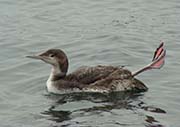Breeding (March-Oct)

06/05/2008 - Half Moon Bay, CA
06/05/2008 - Half Moon Bay, CA
|

09/27/2008 - Port Townsend to Keystone Ferry, Washington
09/27/2008 - Port Townsend to Keystone Ferry, Washington
|

Almost at full breeding plumage
03/12/2009 - Bodega Bay, CA
Almost at full breeding plumage
03/12/2009 - Bodega Bay, CA
|
Non-breeding (Sep-March)

12/23/2010 - Berkeley Pier; Berkeley, CA
12/23/2010 - Berkeley Pier; Berkeley, CA
|

Transitioning to basic or non-breeding plumage
11/01/2011 - Bodega Bay, CA
Transitioning to basic or non-breeding plumage
11/01/2011 - Bodega Bay, CA
|

Stretching the foot out
06/28/2007 - Bodega Bay, CA
Stretching the foot out
06/28/2007 - Bodega Bay, CA
|

Eating a crab
05/16/2008 - Bodega Bay, CA
Eating a crab
05/16/2008 - Bodega Bay, CA
|

05/16/2008 - Bodega Bay, CA
05/16/2008 - Bodega Bay, CA
|

05/16/2008 - Bodega Bay, CA
05/16/2008 - Bodega Bay, CA
|

03/06/2009 - New Orleans Lakefront at Seabrook, LA
03/06/2009 - New Orleans Lakefront at Seabrook, LA
|

03/06/2009 - New Orleans Lakefront at Seabrook, LA
03/06/2009 - New Orleans Lakefront at Seabrook, LA
|
|
Diet:
Common Loons mostly eat fish but will also eat crustaceans,
especially crayfish.
To catch fish they use their excellent sight to locate
fish underwater. They then will dive as deep as 200 feet to catch them.
Parents feed insects and aquatic insect larvae to their chicks.
Courtship:
It is believed that Common Loons pairs re-mate from year to
year but it has not been proved.
Before nesting, the pair spends time together preening and swimming together.
While swimming together they turn their heads side to side and do short dives.
The male will call to the female.
If she accepts they will move to the shore for copulation.
Nesting:
Common Loons prefer to build nests on islands to avoid predation by
mammals and other ground
based predators.
They are built close to the water.
If chicks or eggs are lost to predation, Loons will relocate to a
different nest site and lay
another clutch.
It is believed that Loons will return to the same site each year.
Nests are built on the ground using vegetation such as leaves,
needles, underwater
vegetation, etc.
Both sexes build the nest.
1-2 eggs are laid, the second egg is smaller than the first.
Both parents will incubate the eggs.
The chicks are precocial and leave the nest shortly after hatching.
When they leave the nest, they rarely return to the nest site.
While they can swim immediately, the parents feed and defend them
for about three months.
The chicks will beg for food by making vocal calls and pecking at the
side of the parent's neck.
The chicks will sometimes ride on the back of the parent.
Loons don't begin breeding until they are 3 or 4 years old.
Habitat and Range:
Found throughout North America, they breed in mostly in Canada and the very northern U.S.
on fresh-water lakes.
During winter they are found near both coasts.
Vocalization:
The Common Loon has four calls. The tremolo, which sounds a bit like maniacal laughter, is an aggressive call. The wail is a long, drawn-out sound. The hoot, a shorter call, is used to communicate among parents and young. The yodel is sounded by male loons guarding their territory.
Plumage/Molt:
Loons have two molts, one for the basic or winter plumage,
the second for their alternative or breeding plumage.
The basic plumage happens in late summer on their breeding grounds.
The alternate plumage happens in late winter before going to the breeding grounds.
At this time, all the flight feathers are replaced.
During this time, they are flightless.
Migration:
Unlike most birds, Common Loons are usually the first to arrive and the last to love the breeding
grounds.
Tongue/feet:
No information.
Bibliography:
- McIntyre, Judith W., The Common Loon, Spirit of Northern Lakes,University of Minnesota Press, 1989
- http://www.dnr.state.mn.us/birds/commonloon.html Minnesota Department of Natural Resources, Accessed June 2012
- http://en.wikipedia.org The Free Encyclopedia, Accessed June 2012
- http://animals.nationalgeographic.com/animals/birds National Geographic, Accessed June 2012
Top of Page










